According to many experts, chronic prostatitis is an inflammatory disease caused by an infection with the possible addition of autoimmune disorders, which is characterized by damage to the parenchymal and interstitial tissue of organs. The disease has been known to medicine since 1850, but even today it is still poorly understood and responds poorly to treatment. Chronic bacterial (6-10%) and non-bacterial (80-90%) prostatitis are the most common and socially significant inflammatory diseases in men, which significantly reduces their quality of life. The disease is mainly recorded in young and middle-aged people, and is often complicated by impairment of copulatory and generative functions (reduced potency, infertility, etc. ). The disease in men is recorded in 8 - 35% of cases between the ages of 20 and 40 years.
The cause of bacterial prostatitis is the pyogenic flora, which penetrates the gland from the urethra or by lymphogenic and hematogenous pathways. The etiology of chronic nonbacterial prostatitis and its pathogenesis remain unknown. It mainly affects men over 50 years of age.
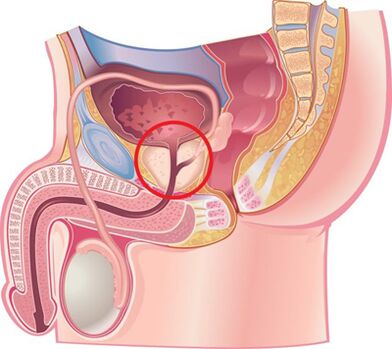
Reasons for disease development
Chronic prostatitis is currently considered a polyetiological disease. There is an opinion that the disease occurs as a result of the penetration of the infection into the prostate, and then the pathological process takes place without its participation. Numerous non-infectious factors contribute to this.
Infectious factors in the development of chronic prostatitis
In 90% of cases, pathogens enter the gland from the urethra, resulting in acute or chronic prostatitis. There have been cases of asymptomatic transport. The course of the disease is influenced by the state of defense of the human body and the biological properties of the pathogen. It is assumed that the transition from acute to chronic prostatitis occurs due to loss of tissue elasticity due to excessive production of fibrous tissue.
Among the causes of chronic prostatitis, the following pathogens have been found:
- In 90% of cases, the disease detects such gram-negative bacteria as Escherichia coli (E. coli), Enterococcus faecalis (fecal enterococci), somewhat less frequently - Pseudomonas aeruginosa, Klebsiella spp. , Proteus spp. , Pseudomonas aeruginogenes and Enterobacter. Gram-positive bacteria enterococci, streptococci, and staphylococci are rare.
- The role of coagulase-negative staphylococci, ureaplasma, chlamydia, trichomonads, gardnerella, anaerobic bacteria and fungi of the genus Candida has not been fully elucidated.
The infection enters the prostate in several ways:
- The ascending route is the most probable, as evidenced by the frequent combination of prostatitis and urethritis.
- Hematogenous prostatitis develops when the infection penetrates the gland through the bloodstream, which is observed in chronic tonsillitis, sinusitis, periodontitis, pneumonia, cholecystitis and cholangitis, purulent skin diseases, etc.
- By contact, chronic prostatitis develops with urethritis and urethral narrowing, when the infection enters the gland ascending with urine flow, with purulent kidney infections, ductal to epipidimitis, deferentitis, and funiculitis, during diagnostic and therapeutic urological manipulations (catheterization, urethralization), including.
- Lymphogenic infection penetrates the prostate with proctitis, thrombophlebitis of hemorrhoidal veins, etc.

Non-infectious factors in the development of chronic prostatitis
Chemical factors
According to experts, the leading role in the development of chronic prostatitis belongs to intraprostatic reflux of urine, when urine is expelled from the urethra into the gland, which leads to damage to the prostate and seminal vesicles.
With the disease, vascular reactions develop, which leads to organ edema, nervous and humoral regulation of the tone of the smooth muscle tissues of the urethra is disturbed, alpha activationone-Adrenergic receptors cause the development of dynamic obstruction and contribute to the development of new intraprostatic refluxes.
Urates contained in urine, with reflux, lead to the development of a "chemical inflammatory response".
Hemodynamic disorders
They support chronic inflammation and circulatory disorders in the pelvic organs and scrotum. Congestion develops in people who lead an inactive lifestyle, for example, drivers, office workers, etc. , With obesity, sexual abstinence, sexual dysmetry, frequent hypothermia, mental and physical overload. Intake of spicy and spicy foods, alcohol and smoking, etc. , Contribute to the maintenance of the inflammatory process.
Other factors
There are many other factors that support chronic inflammation of the prostate. These include:
- Hormonal.
- Biochemical.
- Impaired immune response.
- Autoimmune mechanisms.
- Infectious and allergic processes.
- Characteristics of the structure of the prostate gland, which leads to difficulties in full drainage.
It is often not possible to determine the reasons for the development of chronic prostatitis.
Classification of prostatitis
According to the classification proposed in 1995 by the US National Institutes of Health, prostatitis is divided into:
- Acute (category I). It is 5 - 10%.
- Chronic bacteria (category II). It is 6 - 10%.
- Chronic nonbacterial inflammation (category IIIA). It is 80 - 90%.
- Chronic non-bacterial non-inflammatory (category IIIB) or chronic pelvic pain syndrome.
- Chronic prostatitis, diagnosed accidentally (category IV).
Signs and symptoms of chronic prostatitis
The course of chronic prostatitis is long, but not monotonous. Periods of worsening are replaced by periods of relative calm that occur after complex anti-inflammatory and antibacterial therapy.
The development of chronic bacterial prostatitis is often preceded by urethritis of bacterial or gonorrheal nature, non-bacterial - circulatory disorders in the pelvic organs and scrotum (hemorrhoids, varicocele, etc. ), sexual excesses.
Patients with chronic prostatitis have many complaints. They go to doctors for years, but are very rarely examined for prostate disease. Approximately a quarter of patients do not complain of any disease or the disease progresses with scanty clinical symptoms.
Complaints of patients with chronic prostatitis can be conditionally divided into several groups.
Urinary disorders associated with narrowing of the urethra:
- Difficulty starting to urinate.
- Weak urine flow.
- Intermittent or drip urination.
- Feeling of incomplete bladder emptying.
Symptoms due to irritation of nerve endings:
- Frequent urination.
- The urge to urinate is sharp and violent.
- Urination in small portions.
- Urinary incontinence during the urge to urinate.
Pain syndrome:
- The intensity and nature of the pain are different.
- Localization of pain: lower abdomen, perineum, rectum, groin and lower back, inner thighs.
Sexual dysfunction:
- Pain in the rectum and urethra during ejaculation.
- Slow erection.
- Loss of orgasm.
- Premature ejaculation, etc.
From the nervous system: neurotic disorders in the form of directing patients' attention to their health condition.
Signs and symptoms of chronic nonbacterial prostatitis
Chronic pelvic pain syndrome in men (CPPS) occurs with the usual symptoms for chronic prostatitis, but the bacteria is absent in part 3 of urine and in prostate secretion. CPPS can be simulated by chronic nonbacterial interstitial cystitis, rectal diseases, pelvic floor spastic myalgia syndrome, and functional prostate lesions caused by disorders of organ innervation and its hemodynamics.
If the neurovegetative function is impaired, atony and violation of the innervation of the gland are observed, which is manifested by the difficulty of rapid and complete closure of the lumen of the urethra. At the same time, urine is still excreted drop by drop for a long time after urination. In such patients, the study reveals instability and increased excitability, which is manifested by increased sweating and excitability of cardiac activity, changes in dermographism.
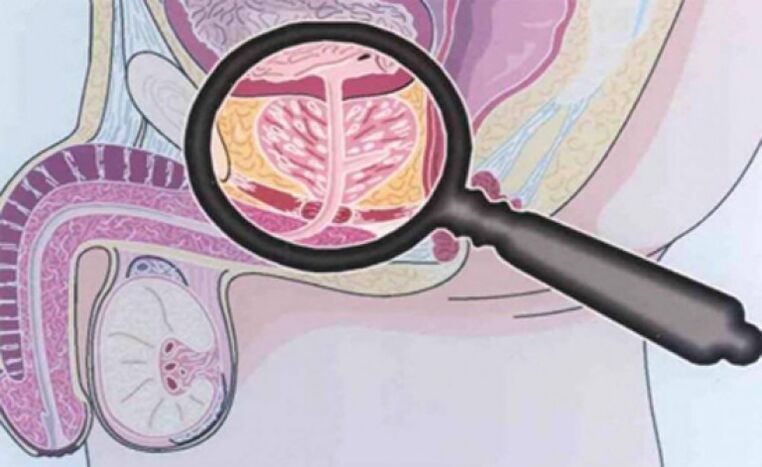
Complications of the disease
The long-term course of chronic prostatitis is complicated by impaired sexual and reproductive functions, the development of diseases such as vesiculitis and epipidimitis, as well as organ hardening. Organ sclerosis worsens local microcirculation and urodynamics, as well as the results of surgical interventions. Fibrosis of the periurethral tissues leads to the development of urination disorders.
Diagnosis
Due to the fact that there are many reasons for the development of chronic prostatitis, a number of diagnostic studies are used for diagnosis. The success of treatment depends on the proper determination of the cause of the disease. The diagnosis of chronic prostatitis is based on the following data:
- The classic triad of symptoms.
- A set of physical methods (digital rectal examination of the prostate).
- A set of laboratory methods (urine analysis and microscopy of prostate secretion, cultivation and determination of the sensitivity of the microflora to antibacterial drugs, general analysis of urine and blood).
- For detection of gonococci, bacterioscopy of urethral smears, PCR and serological methods (for detection of ureaplasmas and chlamydia).
- Urofluometry.
- Prostate biopsy.
- Complex of instrumental methods (ultrasound).
- Determination of the patient's immune status.
- Determination of neurological status.
- If the treatment is ineffective and complications, computer and magnetic resonance imaging, blood sampling, etc. are suspected.
Prostate palpation
In the diagnosis of the disease, palpation of the prostate is of crucial importance, which increases in the period of worsening, and decreases in the period of relaxation of the inflammatory process. In chronic prostatitis during iron deterioration, it is edematous and painful.
The density of the consistency of the organs can be different: the areas of softening and compaction are palpated, the zones of indentation are determined. Palpation can assess the shape of the gland, the condition of the seminal tubercles and surrounding tissues.
The process of transrectal digital examination is combined with the collection of glandular secretions. Sometimes it is necessary to get a secret from each action separately.
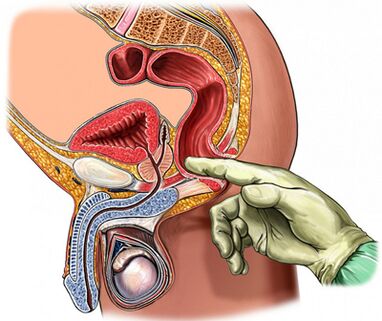
Analysis of a 3-cup urine sample and prostate secretions
The "gold standard" in the diagnosis of chronic prostatitis are:
- Collecting the first portion of urine.
- Collecting the second part of the urine.
- Getting glandular secretion by massage.
- Collecting the third portion of urine.
Further, microscopic and bacteriological examination of the material is performed.
In prostatitis:
- The number of microorganisms (CFU) exceeds 103/ ml (10four/ ml for epidermal staphylococci), but do not neglect even a small number of microbes in tens and hundreds.
- The presence of 10-15 leukocytes in the visual field, detected by microscopy, is a generally accepted criterion for the presence of an inflammatory process.
The secretion of the prostate and the 3rd portion of urine are subjected to microscopic and bacteriological examinations:
- In chronic bacterial prostatitis, there is an increase in the number of leukocytes in the gland secretion and a third of the urine is released after the massage, bacteria (mainly from the intestinal group).
- In nonbacterial prostatitis, there is an increase in the number of leukocytes in the secretion of the gland, but the microflora is not detected.
- With CPPS, there is no increased number of leukocytes and microflora.
Normal prostate secretion rate:
- Leukocytes less than 10 in the field of view.
- There are a lot of grains of lecithin.
- The microflora is absent.
In chronic prostatitis, prostate secretion reveals:
- The number of leukocytes is large - more than 10-15 in the field of view.
- The amount of lecithin grains is reduced.
- The pH of the secretion is switched to the alkaline side.
- The acid phosphatase content is reduced.
- Lysozyme activity is increased.
Obtaining negative results of prostate secretion does not prove once the absence of the inflammatory process.
The value of the prostate secretion crystallization test is retained. Usually during crystallization a characteristic pattern in the form of fern leaves is formed. In the case of violation of the aggregation properties of prostate secretions, such a pattern is not created, which occurs when the androgenic hormonal background changes.
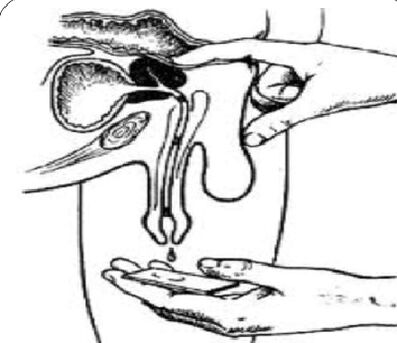
Ultrasound procedure
If prostate disease is suspected, an ultrasound examination of the gland itself (transrectal ultrasound is optimal), kidneys and bladder is used, which enables the determination of:
- Gland volume and size.
- The presence of stones.
- Seed bag size.
- Condition of bladder walls.
- The amount of residual urine.
- Scrotal structures.
- Another type of pathology.
Other prostate examination methods
- The state of urodynamics (urine flow rate study) is easily and simply determined using a study such as uroflowmetry. With the help of this study, it is possible to detect signs of obstruction at the exit of the bladder in a timely manner and conduct dynamic observation.
- A puncture biopsy is performed if abscess formation, benign hyperplasia and prostate cancer are suspected.
- In order to clarify the reasons for the development of infravesicular obstruction, X-ray and endoscopic studies are being performed.
- With a long-term inflammatory process, urethrocystoscopy is recommended.
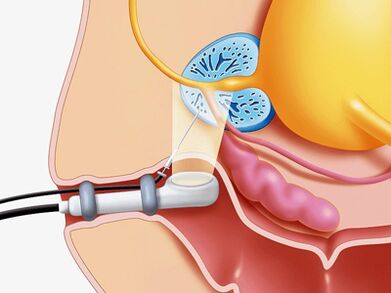
Differential diagnosis
Chronic prostatitis should be distinguished from vesiculoprostatosis, autonomic prostatopathy, congestive prostatitis, pelvic floor myalgia, neuropsychiatric disorders, pseudodysynergia, reflex sympathetic dystrophy, inflammatory diseases of other organs: interstitial cystitis, osteitis of the vesicular prostatic arthritis, inguinal hernia.
Treatment of chronic prostatitis
Treatment of chronic prostatitis should begin with a change in the patient's lifestyle and diet.
In the treatment of the disease at the same time drugs are used that affect different links of pathogenesis.
The main directions of therapy:
- Elimination of causative microorganisms.
- Anti-inflammatory therapy.
- Normalization of blood circulation in the prostate and pelvic organs.
- Normalization of appropriate drainage of the prostate acinus.
- Normalization of hormonal profile.
- Prevention of organ hardening.
Drugs of the following groups are used to treat chronic prostatitis:
- Antibacterial.
- Anticholinergic.
- Vasodilators.
- Alphaone–Adrenergic blockers.
- 5 alpha reductase inhibitors.
- Cytokine inhibitors.
- Nonsteroidal anti-inflammatory.
- Angioprotectors.
- Immunomodulators.
- Drugs that affect urate metabolism.
Antibiotics in the treatment of chronic bacterial prostatitis
Antibiotic therapy should be performed taking into account the sensitivity of the identified microorganisms to antibiotics. If the pathogen is not identified, empirical antimicrobial treatment is used.
The drugs of choice are fluoroquinolones of the II-IV generation. By common methods of application they penetrate rapidly into the tissues of the gland, are active against a large group of gram-negative microorganisms, as well as ureaplasma and chlamydia. In case of failure of antimicrobial treatment, it should be assumed:
- resistance of microflora to several drugs,
- short (less than 4 weeks) courses of treatment,
- wrong choice of antibiotic and its dose,
- changes in the type of pathogen,
- the presence of bacteria living in the prostate ducts, covered by a protective extracellular membrane.
The duration of treatment should be at least 4 weeks with mandatory subsequent bacteriological control. If there are more than 10 bacteriuria in the 3rd part of urine and prostate secretions3CFU / ml, a repeated course of antibiotic therapy is prescribed for a period of 2 to 4 weeks.
Cytokine inhibitors in the treatment of chronic prostatitis
Cytokines are glycoproteins that are secreted by immune and other cells in response to the inflammatory response and the immune response. They actively participate in the development of the chronic inflammatory process.
Nonsteroidal anti-inflammatory drugs
Nonsteroidal anti-inflammatory drugs have anti-inflammatory effects, relieving pain and fever. They are widely used in the treatment of chronic prostatitis in the form of tablets and suppositories. The most effective route is rectal administration.
Immunotherapy
In the treatment of bacterial chronic prostatitis, in addition to antibiotics and anti-inflammatory drugs, immunomodulatory agents are used. The most effective is the rectal route of their application. An immunomodulator is widely used, which increases the functional activity of phagocytes, which contributes to more efficient removal of pathogens.
Alpha-blockers in the treatment of chronic prostatitis
Alpha-1 adrenergic blockers have been found to normalize the tone of the smooth muscles of the urethral prostate, seminal vesicles, and prostate capsule, making drugs of this group very effective in treating the disease. Alpha-1 adrenergic blockers are used in patients with severe urinary disorders in the absence of an active inflammatory process.
In CPPS, the duration of treatment is 1 to 6 months.
5a-reductase inhibitor in the treatment of abacterial prostatitis and CPPS
It was found that under the influence of the enzyme 5a-reductase, testosterone is converted into the prostatic form of 5a-dihydrotestosterone, whose activity in prostate cells is more than 5 times higher than the activity of testosterone itself, which in the elderly leads to organ enlargement due to epithelial and stromal components.
When taking 5a-reductase inhibitors for 3 months, atrophy of stromal tissue is noticed, within 6 months - glandular, secretory function is inhibited, the severity of pain syndrome and gland volume are reduced, tension and edema of organs are reduced.
The role of antisclerotic drugs in the treatment of chronic prostatitis
With prolonged inflammation in the prostate, fibrosis develops which is manifested by impaired microcirculation and urodynamics. Antisclerotic drugs are used to prevent the process of fibrosis.
Other drugs used to treat chronic prostatitis
Along with the drugs described above, the following are used to treat the disease:
- Antihistamines.
- Vasodilators and angioprotectors.
- Immunosuppressants.
- Drugs that affect the metabolism of urate and trisodium salts of citric acid.
Herbal products
Effective in the treatment of prostatitis is the use of a composition in the form of a suppository containing a complex of biologically active peptides isolated from bovine prostate.
Under the influence of the drug comes:
- Stimulation of metabolic processes in glandular tissues.
- Improving microcirculation.
- Reduction of edema, leukocyte infiltration, stagnation of secretions and pain.
- Prevention of thrombosis in prostate veins.
- Increased activity of the secretory epithelium acini.
- Improving sexual function (increasing libido, restoring erections and normalizing spermatogenesis).
Prostate prostate massage with fingers
Numerous researchers claim that finger massage should be used for chronic prostatitis, taking into account the known contraindications.
Physiotherapy
The effectiveness of physiotherapeutic procedures in the treatment of prostatitis has not been proven today, the mechanism of action has not been scientifically established, and side effects have not been studied.
Prevention of chronic prostatitis
When you start preventing the development of chronic prostatitis, you should know:
- The risk of developing the disease increases with age.
- Representatives of the Negroid race are more prone to diseases.
- Familial predisposition to the disease is not excluded.
People with a predisposition for the development of chronic prostatitis should be more careful about their health condition.
Disease prevention tips:
- Drink plenty of fluids. Frequent urination promotes flushing of the microflora from the urethra.
- Prevent diarrhea and constipation.
- Eat a balanced diet. Avoid eating foods rich in carbohydrates and saturated fats, which leads to weight gain.
- You should limit the use of substances that irritate the urethra as much as possible: spicy and spicy foods, smoked meat, sauces and spices, coffee and alcohol.
- Stop smoking. Nicotine negatively affects the condition of vascular walls.
- Don't catch a cold.
- Do not delay bladder emptying.
- Lead an active lifestyle, exercise. Exercise to strengthen the pelvic floor muscles, which can eliminate venous congestion, which in turn supports normal prostate function.
- He leads a regular sex life. Avoid prolonged abstinence. The gland must get rid of the secretion immediately.
- Stay in a monogamous relationship. Nonselective sex increases the likelihood of acquiring sexually transmitted diseases.
- If you have complaints of genitourinary organs, consult your urologist immediately.

























